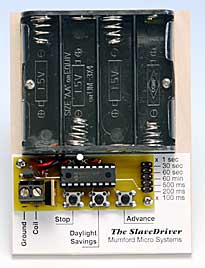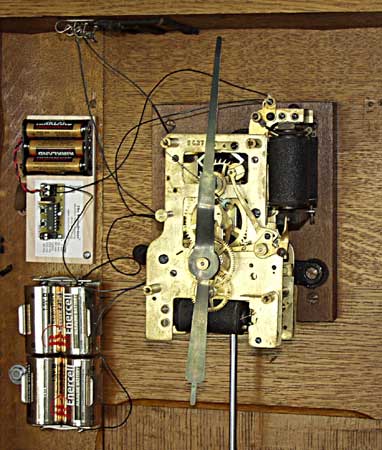The Slave DriverTurn antique slave dials into functioning clocks Advance or retard one hour for daylight savings with a pushbutton.
We make a miniature electronic Master Clock that will easily fit inside a slave dial and run it as an accurate clock. The SlaveDriver, as I call it, is shown at left. The SlaveDriver is a small microprocessor with a quartz crystal. It runs on four size AA batteries for many months. A separate battery supply is used to power whatever slave you will be using. For example, shown below is the back of a Standard Electric slave dial with the SlaveDriver and batteries resting inside. This dial runs on three volts, and two "C" cells work just fine. As you can see, the SlaveDriver and all batteries easily fit inside the case when it hangs on a wall. You do not need to run wires to the dial to make it work.
There are three small push buttons with which you can synchronize the clock to exact time. If you push the STOP button, all impulses to the dial will be prevented. You then wait until the clock is exactly one interval slow (30 or 60 seconds). Then, you press the ADVANCE button once. This will cause the clock to advance one interval and start the timing. The next impulse will occur exactly one interval (30 or 60 seconds) later. The quartz crystal in the Slave Driver is adjusted to be accurate to within two or three seconds per week, though this may drift a little with extreme temperature changes. A third push button allows you to change the time for daylight savings. Push the "Daylight Savings" button and then the "Advance" button to move ahead one hour. An impulse will be generated every second until the clock has advanced one hour. Push the "Daylight Savings" button and then the "Stop" button, and the Slave Driver will inhibit all impulses until an hour has passed. A terminal block is provided for connection of the slave dial and batteries. The SlaveDriver can switch up to 30 volts and five amps, though slave dials use much less power than this. You can easily conceal the batteries and SlaveDriver behind the dial. If your slave needs three volts, two "C" cells can be used. If your slave needs 12 volts, use ten "AA" batteries. If your slave needs 24 volts, use three 9 volt batteries. These batteries will last a long time because the slave is only on for a fraction of a second once or twice a minute.
The SlaveDriver can be used to reset these clocks. There is a special configuration setting on the Driver that will cause it to generate an impulse signal once per hour. When connected to the synchronizer solenoid, it will reset the minute hand to the 12 position with the accuracy of the quartz timebase in the SlaveDriver. You don't even need to add another power supply. The 3 volt batteries that run a Self Winding clock can be used to run the synchronizer as well. In the picture you can see the SlaveDriver mounted above the batteries in a Self Winding clock. The synchronizing solenoid can be seen as a black cylinder in the upper right corner of the movement. Small wires connect the SlaveDriver to the coil and to the clock batteries. (The Slave Driver in this picture is an earlier model than the current design.) At the present time I am not making Slave Drivers for sale.
Home | Horology | MicroSet | Clock circuits Voltage regulators | SlaveDriver | Governor | Semiconductor switch | EM controller
|
 Slave Dials
Slave Dials There are many varieties of slave dials, and the SlaveDriver can be customized to work with most them. At the right end of the circuit board are several metal pins where you can apply jumpers to select the parameters of operation. It can be configured to provide an impulse every second, every 30 seconds, every 60 seconds, or once per hour. The duration of the impulse can also be set, from as short as 100 milliseconds to as long as 1 second.
There are many varieties of slave dials, and the SlaveDriver can be customized to work with most them. At the right end of the circuit board are several metal pins where you can apply jumpers to select the parameters of operation. It can be configured to provide an impulse every second, every 30 seconds, every 60 seconds, or once per hour. The duration of the impulse can also be set, from as short as 100 milliseconds to as long as 1 second. Western Union and Self Winding Clock Company
Western Union and Self Winding Clock Company